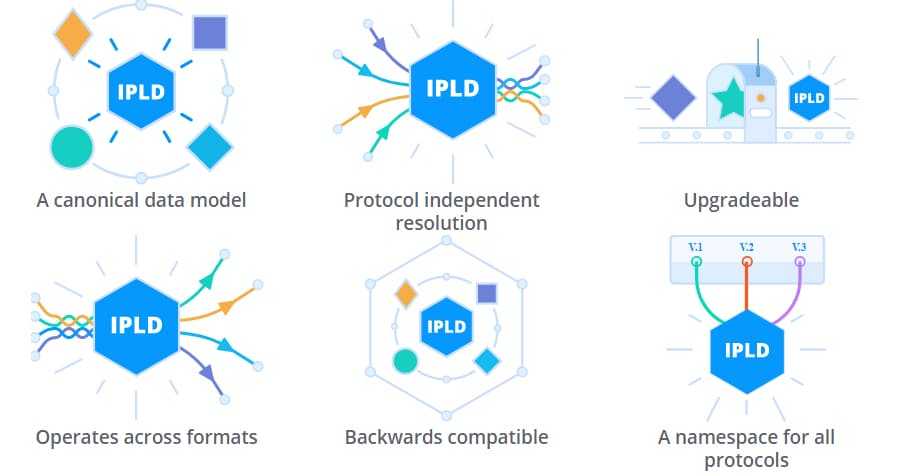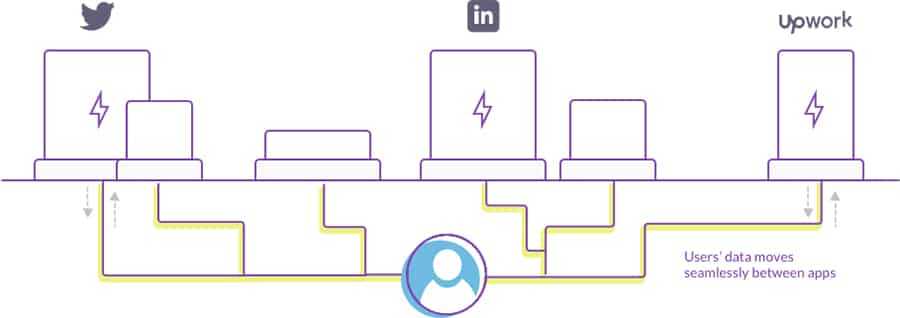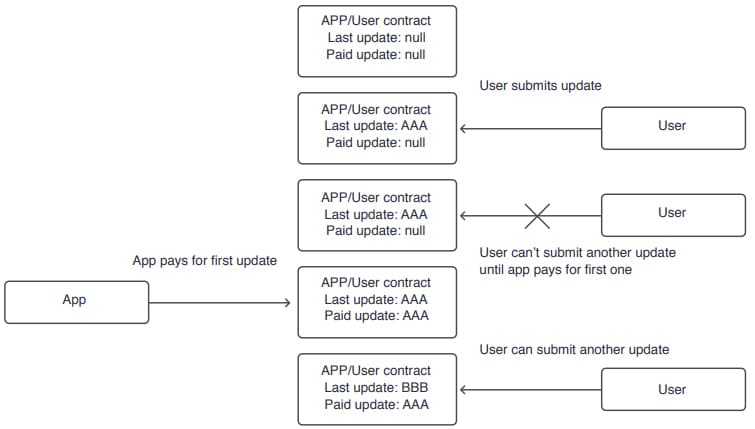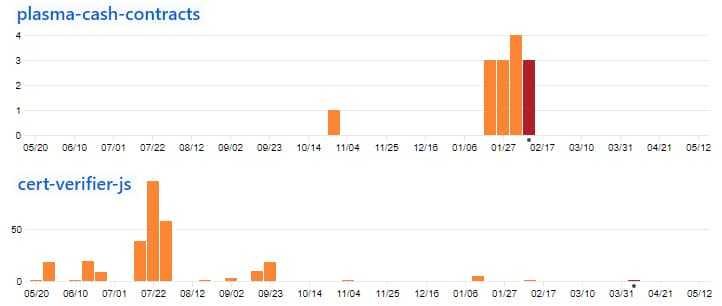Dock Coin Review: Digital Credential Blockchain Protocol
Dock.io (DOCK) is an interesting project that is trying give users control over their own digital credentials and professional achievements.
It is a decentralised exchange protocol that uses blockchain technology to create a transparent and secure credential sharing ecosystem. Think of it as a decentralised version of Linkedin that keeps control of the data entirely in the hands of the user.
Sounds interesting, but can Dock really achieve this?
In this Dock review I will give you everything that you need to know about the project including its technology, use cases and roadmap. I will also analyse the adoption potential of the DOCK tokens.
How Dock Works
Sharing data on the Dock.io platform is a simple concept. Users upload whichever data they like to the platform and decide who can access that data.
They can connect with companies or applications on the platform and each of these relationships is recorded on the blockchain through a smart contract on the Ethereum blockchain. This is a critical difference from the current centralized platforms, where users can control who views their data, but cannot control the platform's access to their data.

With Dock users can share their data in a public unencrypted way so that everyone on the platform can see the data. This is data that isn’t considered sensitive by the user such as their name, education, work history, etc. It’s crucial to know that once data is published publicly it remains public forever. There is no way to remove the data from the public realm.
It is also possible for users to encrypt their data to keep it private. Data is encrypted on Dock by default. Once encrypted only the user can decrypt or grant access to an application to decrypt the data. This means user data remains fully in control of the individual user.
The data itself can have a variety of formats, and the user community will be able to choose the data formats, according to the whitepaper. Some critics have questioned how well this will work, and have suggested that standardization of the data formats will be necessary. The platform has stated with the resume and work history data formats.
The solution being used by Dock is known as data format signaling, where the application's signal which data formats they will accept. The team believes that consensus over accepted data formats can be achieved through natural market equilibrium.
The Technical Side of Dock
The Dock platform is built on the Ethereum blockchain and given the network congestion already seen on Ethereum there’s no way for Dock to store and retrieve resume data and the other data it is built to hold.
So, the Dock team is using the IPLD specification, which was created to help the open-source peer-to-peer Interplanetary File System (IPFS) perform content addressable data exchange.

The IPFS network is similar to a torrent network, but it stores hashed files rather than torrent files. These hashed files are stored in the collection of IPFS nodes, and any time a user needs to retrieve a file they do so by calling its associated hash from the blockchain. This lowers the overhead for the blockchain since it doesn’t need to store the data, just an associated hash.
While the platform is committed to the Ethereum blockchain, for now, the team has said that they will consider creating their own native, standalone blockchain in the future if it becomes necessary.
The Dock Data Sharing Model
Dock data sharing is controlled by the tokenomics model of the platform, which is pretty unique in the world of decentralization and incentivization.
The first difference is the DOCK token denomination, which the team has said should be done in fiat rather than Ethereum like most projects. In fact, the ICO was valued in USD rather than Ethereum.

The reasoning for this is to encourage price stability. It’s well known how volatile cryptocurrency prices can be and the team believes that by using fiat to denominate the DOCK token they can avoid extreme price swings.
The other difference is the way Dock creates incentives, which is focused on applications rather than users.
Dock Application Incentives
The Dock system has created incentives for applications to share data with each other via the DOCK tokens. Basically, if an application wants to acquire data from another application it needs to pay for that data.
This system also prevents applications from hoarding data because the sharing of data is involuntary. There is no way for an application to prevent another application from paying for its data. Only the user can create rules that prevent data from being shared. In this way, Dock prevents data hoarding from occurring on the platform.
Dock User Incentives
Unlike nearly every other decentralized platform with tokens, the Dock platform does not incentivize users to share their data. This was done intentionally and deliberately. The Dock team wants people to come to the realization that their data is far more valuable than they believe, and that any amount paid for their personal data isn’t enough. Instead, they want users to value their data for its own sake.
There’s another reason not to incentivize users for providing data, and that’s to avoid a flood of people spamming the platform with false information simply to collect rewards. Dock realizes this would be the fastest way to kill the platform, and they are avoiding it in any way possible.

Moreover, the lack of incentives actually makes things clearer for users, who won’t have to worry about keeping up with micro-transactions and payments. All they have to focus on is making sure that their personal information is up to date.
Rather than offering small payments for valuable data, Dock is giving users complete control over their data and convenience. By keeping data all in one place users are easily able to control who can access their data, and they can maintain the data without having to go through the trouble of remembering all the different sites that have a profile for them. This keeps data always updated across the web and avoids scenarios where people are seeing data that are no longer up-to-date.
Dock Team & Investors
The Dock team consists of 16 members who are located across the globe, although the project is headquartered in San Francisco, California. The core team has worked on projects together in the past, with many coming from Remote.com.
The CEO and co-founder of the project is Nick Macario, who came to Dock with more than 10 years of experience in web and mobile application marketing. Most recently he was the co-founder and CEO of Remote.com.

The other co-founder and COO of the project is Elina Cadouri, who was also a co-founder and CEO for Outsource.com. She has over 8 years of experience in marketing research.
Dock has also received investments from a number of traditional and blockchain focused venture capital funds. These include the likes of Passport Capital, the Digital Asset Fund, Blockwater Capital and Connect capital among others.
The Dock Community
When it comes to increasing adoption and awareness for a project, a large and enthusiastic community is essential. This is especially the case with Dock where the ecosystem relies on these users sharing their data.
Dock has a fairly large following on social media, which is typically a good sign for a blockchain project. Their Telegram group has almost 25,000 members, and their Twitter has 45,800 followers. They are even well represented on Facebook, with nearly 35,000 followers.
One disconnect is the project’s subreddit. While they have over 15,000 followers, there is almost no interaction. The Dock team is pretty much the only ones posting there, and the postings have very few and often no comments.
The DOCK Token
Dock held their ICO in February 2018 and sold 30% of the 1 billion total supply for $0.08329 each, raising $20 million. The tokens weren’t released until April 2018 and soon after the DOCK token hit an all-time high of $0.242743 on May 4, 2018.
From there the bear market took over and the token sank throughout the rest of 2018, finally reaching a bottom on January 10, 2019, when the token hit $0.007543. It subsequently made it as high as 0.020441 in April 2019, but as of May 13, 2019, it has dropped back to $0.011445 and is roughly 90% off its ICO price.

The DOCK token isn’t listed on too many exchanges, but it is on Binance and that’s where nearly all the trading in the token takes place. There’s also a tiny amount of trading on Huobi Global, KuCoin, and Gate.io.
This could create an issue from an exchange reliance perspective. Given that most of the BTC volume of DOCK is being traded on Binance, liquidity could fall off a cliff if there was ever a de-listing. While this is not likely, it is a concern that potential traders have to consider.
Once you have bought your DOCK, you are going to want to get it off the exchange if you intend on hodling them. Because DOCK is an ERC-20 token it can be kept in any ERC-20 compatible wallet, such as MetaMask or MyEtherWallet.
Dock Development & Roadmap
Determining exactly how much work is being done on a blockchain project is sometimes tricky. However, one of the quickest methods to estimate this is to take a look at the coding activity in their public code repositories.
Hence, I decided to jump into the public GitHub for Dock.io and see how many code commits the developers were pushing through. There are 12 repos in total in their GitHub but below are the commits for two of their most active.

As you can see, there is not that much activity in these repos. The last public commit to their plasma Cash repo was back in February. The rest of the 12 remaining repos are similarly barren.
Of course, there is always the possibility that the developers are coding on the project in private repos. Yet this is less than optimal from a transparency perspective as their community is not able to monitor the progress of the project.
Having said this, the team is keeping the community up to date with developments through their official blog. They release monthly updates with a breakdown of what was achieved by the team over the past month.
For example, in their April update they went over some work that they have done on their wallet as well as progress that has been made on the platform. They also gave an outline of what we could expect in the coming months.
There was no timeline given for these updates so it will be interesting to see how long it takes before the next big technology roll-out.
Conclusion
Dock has an impressive long-term vision for the shape of the user data economy that’s going to grow exponentially now that blockchain technology has become available. The success or failure of the platform is going to depend on how quickly it can attract major partners and how quickly it can grow.
On the growth front, the platform already claims over 1 million registered users in just over a year, which is pretty impressive when you consider users don’t receive any incentive for sharing data.
Obviously the slow rate of development in the project's GitHub could be an area for concern. Hence, we will be keeping an eager eye on project announcements and code commits to their repos over the coming months.
We’ve also talked about the risks associated with the lack of standardization in data formats. This could also hinder growth for Dock, although the team believes that as the user base grows the data format issue will take care of itself through natural market equilibrium. If this doesn’t occur users could leave the platform due to a lack of convenience.
And of course, when discussing personal privacy issues there is always related regulatory risks. In the European Union, we already have the GPDR, which is the strictest data protection regulation so far. It’s possible other countries could follow the lead of the EU.
Dock has said its platform fully complies with the principles of GPDR, but that isn’t legally binding and regulators could take issue with the platform as it grows in size and influence.
Disclaimer: These are the writer’s opinions and should not be considered investment advice. Readers should do their own research.
